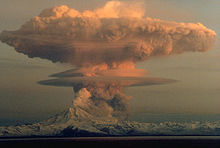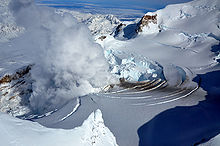Subglacial volcano
A subglacial volcano is a volcano whose main crater is under a glacier .
Occurrence
Areas with a particularly large number of subglacial volcanoes are in the polar regions , especially on the island of Iceland , Alaska and Antarctica . But also high mountain regions, for example in Japan , with the Fujiyama , one of the most famous volcanoes in the world, the Kamchatka Peninsula in Russia or the Andes z. B. in Chile , Bolivia and Peru have such volcanoes.
Geological characteristics
A distinction must be made here between mountains that are only covered by glaciers in the summit area, such as the Andean peaks or the Kamchatka on the one hand, and the mountains in Antarctica or Iceland that are almost completely under the ice on the other. In the first case the structure of the mountains can i. General clearly, usually is Strato or Calderavulkane . On the other hand, the structure of mountains lying under the ice can only be approximated with the help of computer and satellite technology.
Stratovolcanoes are built up from alternating layers of lava and ash. If it is a central volcano , it will mainly consist of rhyolite , as is the case with Torfajökull , and will have formed at least one caldera - usually filled with ice in this case .
In the meanwhile exposed mountains from the Ice Age , one recognizes that, if they were under a glacier, they consist of palagonite tuff or hyaloclastites and pillow lavas , which have formed cones over a chimney, but palagonite ridges over an eruption fissure , e.g. B. Sveifluháls near Krísuvík in the southwest of Iceland.
Typical breakouts

These are explosive and phreatomagmatic eruptions , which are usually accompanied by glacier runs or lahars and can cause enormous damage, as was the case with the volcanic disaster in Armero in Colombia when the glacier-covered Andean volcano Nevado del Ruiz erupted in 1985.
Course of subglacial eruptions
Magma that rises through chimneys or crevices during a volcanic eruption and reaches the boundary between the rock layer and the ice cover, often several hundred meters thick, first melts a cavity in the ice. At the same time, the ice sinks more or less quickly and strongly on its surface and a kind of kettle is formed. The cavity above the magma fills up to 9/10 with meltwater during large eruptions and a corresponding thickness of the ice. From this ratio, however, the glacier floats on the meltwater, the same breaks through the ice barrier and rushes down the slopes in a huge tidal wave. This process could z. B. observed in 1996 during the eruption of the volcano Gjálp under the Vatnajökull glacier shield .
As long as the water pressure above the magma is still sufficient, pillow lavas form over the eruption site. If the eruption ends in this phase, a back or a cone of such lavas remains. An example would be Sigalda near the Hekla volcano in Iceland.
However, if the water pressure falls below a certain limit, a phase change into a phreatomagmatic or explosive phase takes place. Tephra or other volcanic loose materials such as breccia or slag are produced in more or less large quantities . If the eruption stops here, the result is palagonite ridges .
However, if the eruption continues, lava begins to flow out, fills the crater and flows down the flanks or over the glacier. If the crater was initially filled with (melt) water, the lavas must first build up to the surface of the water in the form of pillow lavas and only then are lava layers produced on them, which then pile up like on dry land. But because the glacier holds the materials in a strict shape, the flanks of the tabular volcano that builds up will be very steep. Examples of such tabular volcanoes are The Table in the Canadian Cascades mountain range or Herðubreið in Iceland.
More well-known examples
In Iceland, 4 glaciated volcanoes in particular have been active in the last few centuries: Grímsvötn and Öræfajökull , both of which are covered by the enormous glacier shield of Vatnajökull (approx. 8,000 km 2 ), Eyjafjallajökull and Katla .
Recently, i. H. in March and April 2010, Eyjafjallajökull in particular made a name for itself. In this case, a stratovolcano lies under a medium-sized glacier crest. The eruption in the spring of 2010 produced ash clouds up to 8,000 m high, a rather medium-sized eruption (cf. volcanic explosion index ), which, however, due to the composition of the clouds from particularly fine-grained andesite particles and the unfavorable wind directions , prevented air traffic in Europe for almost a week severely disabled.
Mount Redoubt in Alaska, for example, had major eruptions in 1990 and 2009, with ash and the like. a. fell on Anchorage .
See also
Web links
-
Deutschlandfunk.de Science in focus August 22, 2010, Monika Seynsche : Playing with fire - when volcanoes meet glaciers
- Current research July 16, 2018, Volker Mrasek : [ Boiling under the ice ]
- Smithsonian Institution Global Volcanism Program , volcano.si.edu: Weekly Volcanic Activity Report [worldwide]



